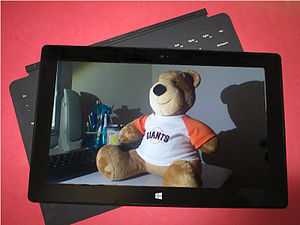Surface (1st generation)
 | |
| Developer | Microsoft |
|---|---|
| Product family | Microsoft Surface |
| Type | Tablet computer |
| Release date |
Announced June 18, 2012 Released October 26, 2012 |
| Operating system | Windows RT |
| CPU | Nvidia Quad-core Tegra 3 |
| Memory | 2 GB of RAM |
| Input |
Two 720p HD LifeCams, front and rear facing Two Microphones, Stereo Speakers, headset jack |
| Connectivity |
Wi-Fi (802.11 a/b/g/n) Bluetooth 4.0 |
| Power |
Built-in rechargable Li-Po 31.5 W-h 24W power supply |
| Online services | Windows Store, OneDrive, Outlook.com, Microsoft Account, Xbox Music, Xbox Live |
| Dimensions |
10.81 by 6.77 by 0.37 inches (27.46 × 17.20 × 0.94 cm) 1.5 pounds (680 g) VaporMg casing Dark Titanium color Windows Button Volume and Power Buttons 16:9 Widescreen |
| Weight | 1.5 lbs |
| Successor | Surface 2 |
| This article is part of a series on the |
| Surface Family |
|---|
The first-generation Surface (formerly Surface with Windows RT, then Surface RT) is a tablet computer created and sold by Microsoft. The device has a 10.6 in ClearType Display and runs Microsoft's Windows RT operating system. It is marketed towards the consumer end of the tablet market, but it is still geared towards productivity. Surface can play games, browse the web, edit Microsoft Office documents, access social networks and can be used for a variety of other purposes.
The device was announced at a press-only event in Los Angeles and is the first PC Microsoft has ever designed and manufactured in house.[1] The Surface is WiFi only, with no cellular variant. The tablet went on sale in eight countries, Australia, Canada, China, France, Germany, Hong Kong, the United Kingdom, and the United States. The Surface Pro was launched later.[2]
The device launched with mediocre reviews, such that the device was not powerful enough, and the Touch Cover lacked an amazing typing experience. Analysts were also concerned that Microsoft might be cannibalizing Windows sales through other OEMs as the Surface was made in-house.[3] Microsoft's main target from the beginning was the Apple iPad and consumer tablet marketshare. After taking a $900 Million dollar write down, they lowered the tablet's overall prices.[4]
Hardware
The Surface tablet has a display of 1366x768 pixels on a five-point multi-touch touchscreen. The device is 10.81 x 6.77 x 0.37 in with Gorilla Glass 2.
Software
Surface runs Windows RT, which is preloaded with Windows Mail, Calendar, Contacts, Sports, News, Travel, Finance, Camera, Weather, Reader, SkyDrive, Store, Photos, Skype, Maps, Games, Messaging, Bing, Desktop, and Xbox Music and Xbox Video. Surface comes with Microsoft Office Home and Student 2013 RT software which has Word, PowerPoint, Excel, and OneNote in the Desktop app. Windows RT only installs new apps downloaded from the Windows Store and is compiled entirely for the ARM instruction set architecture.
A major update to Windows RT 8.0 was launched October 17, 2013 called Windows RT 8.1. This update brought many improvements such as bringing an overhauled mail app, more Bing apps like Reading List and OneDrive (updated from SkyDrive) to the Surface. It brought larger tiles, a help and tips app, Internet Explorer 11, Outlook 2013 RT, changes to PC Settings, lockscreen photo slideshow, infinitely re-sizable apps, a start button, and speed improvements. Later, an update to Windows RT 8.1, dubbed Windows RT 8.1 Update[5] brought search button on the Start Screen, as well as the taskbar on the Modern UI, and a title bar for Modern UI apps.
Accessories
Surface launched with two accessories, the Type cover and the Touch Cover. The Touch Cover came in white, black, magenta, red, and cyan, while the Type Cover came in black. Limited edition Touch Covers were released featuring laser-etched artwork on the back. The Touch and Type Covers double as keyboards and magnetically attach to the Surface's "accessory spine".
Later, adapters for micro-HDMI to HDMI [6] and VGA were released.
References
- ↑ "Microsoft Surface based Windows Tablet announced".
- ↑ "Microsoft Surface to be sold in eight countries".
- ↑ "Surface's Success Will Sink Windows RT OEMs". October 18, 2012. Retrieved July 16, 2014.
- ↑ http://www.geekwire.com/2013/surface-rt-ipad-microsoft-debuts-ad-touting-price-900m-charge/. Missing or empty
|title=(help) - ↑ http://www.microsoft.com/surface/en-us/support/getting-started/get-to-know-windows. Missing or empty
|title=(help) - ↑ http://www.microsoft.com/surface/en-us/support/music-photos-and-video/connect-surface-pro-to-a-tv-display-or-projector
External links
| Preceded by – |
Surface 1st generation |
Succeeded by Surface 2 |
| ||||||||||||||||||||||||||||||||||||